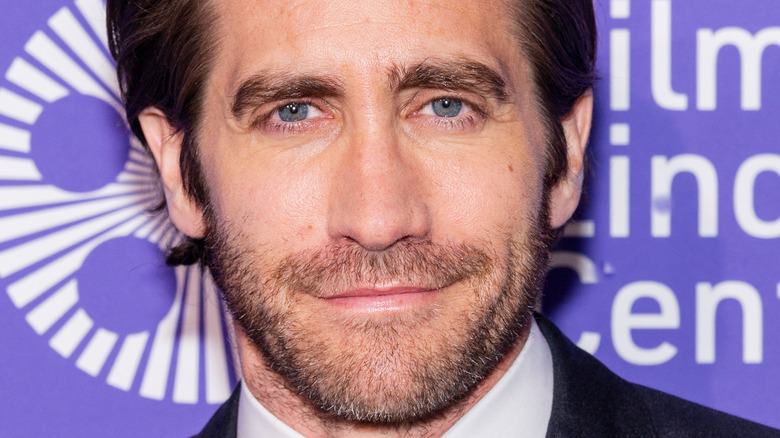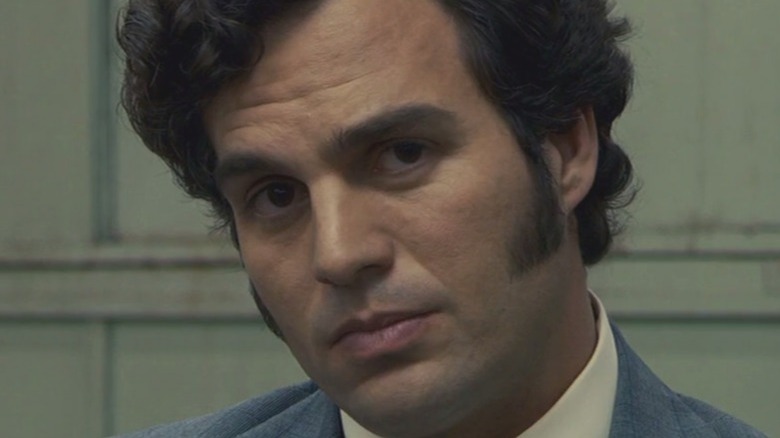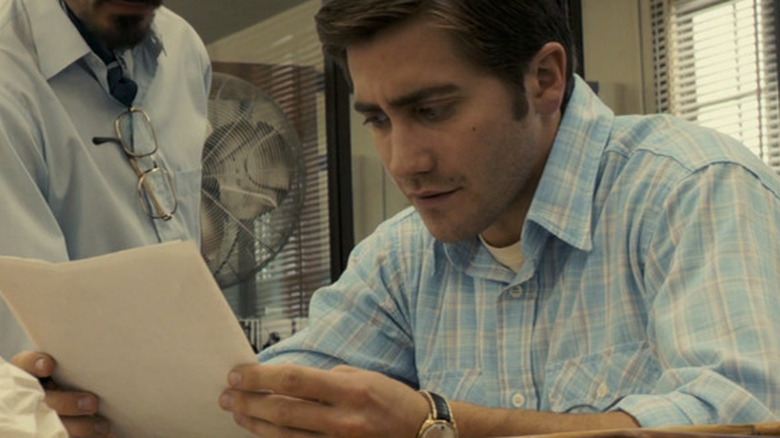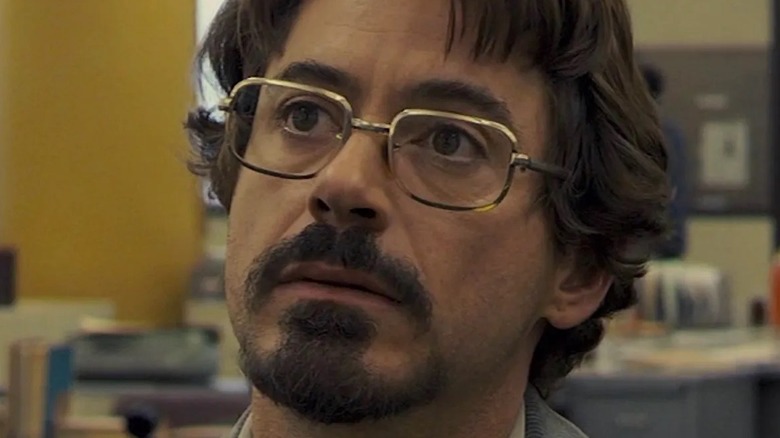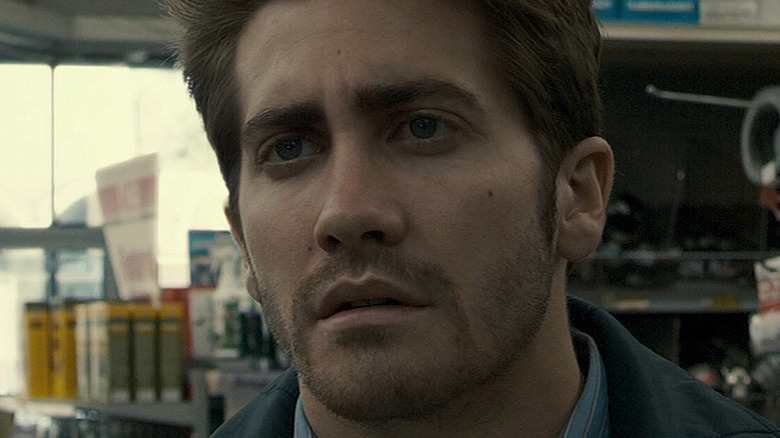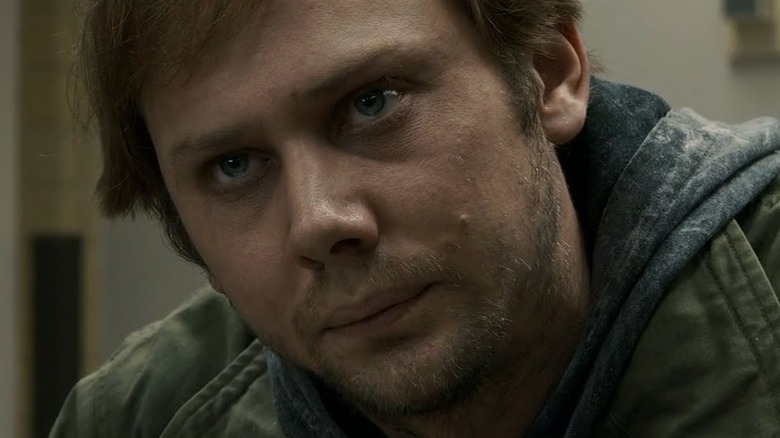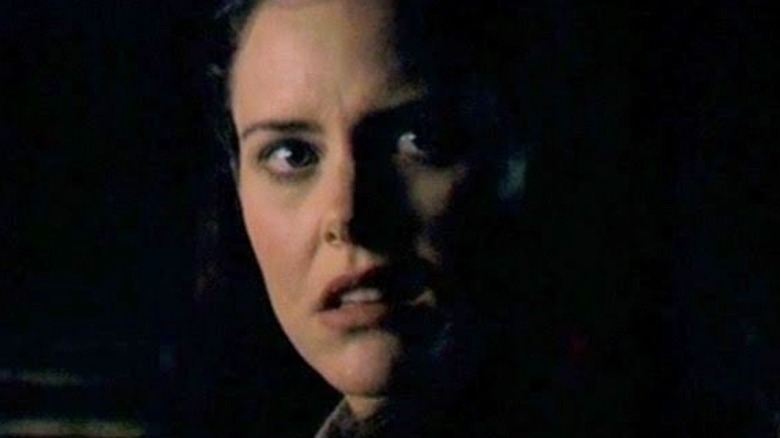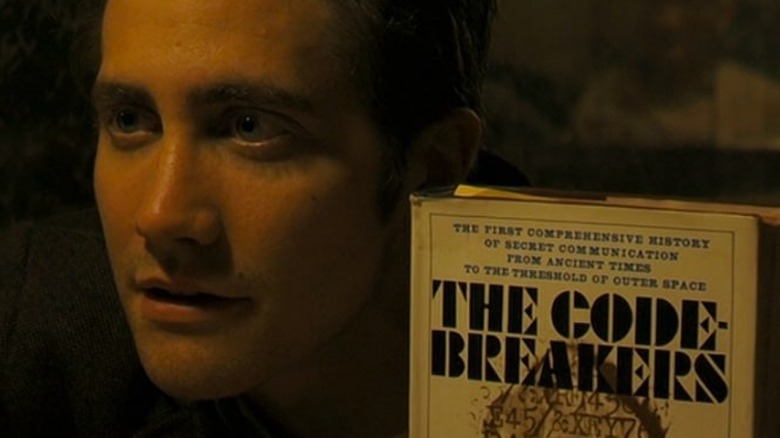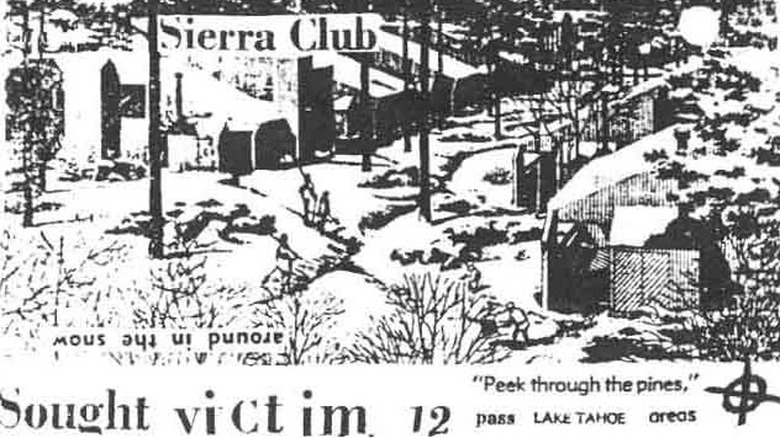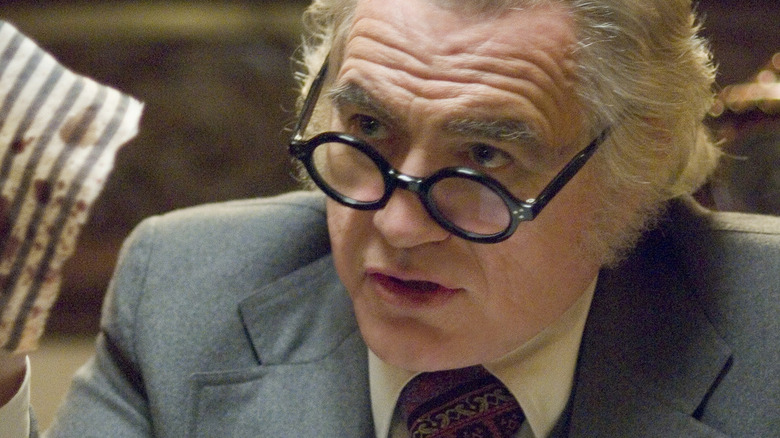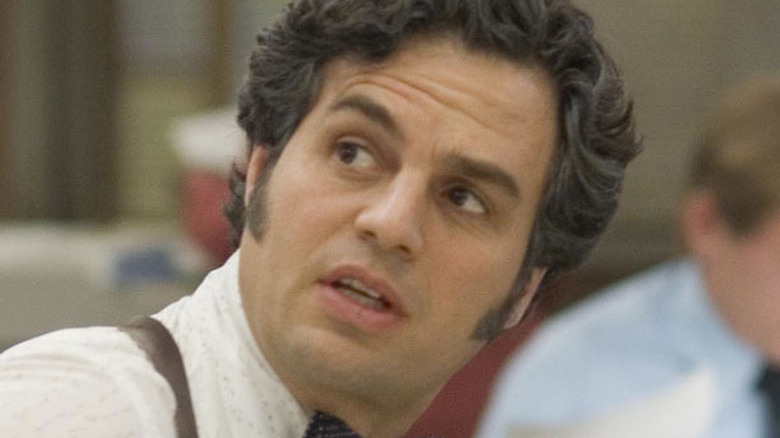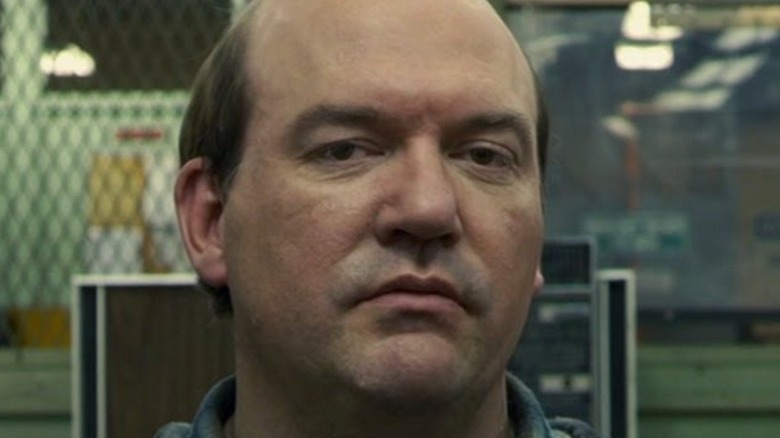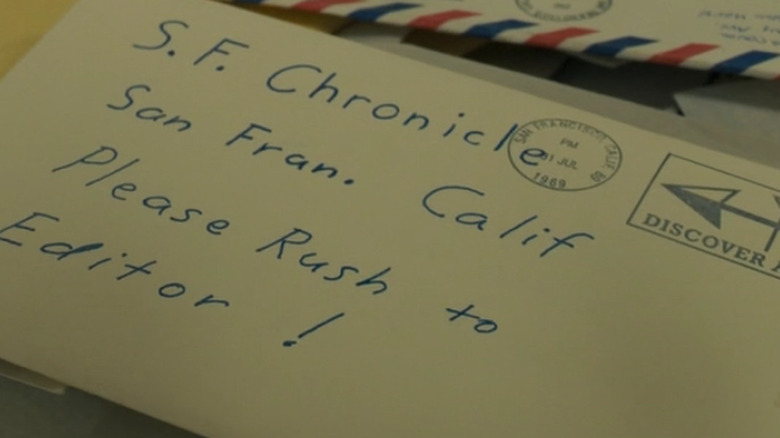Everything Zodiac Doesn't Tell You About The True Story
Before they were superheroes taking on Thanos in the Marvel Cinematic Universe, Mark Ruffalo and Robert Downey Jr. were trying to figure out who was behind one of the most well-known crime sprees in California's history. The 2007 film "Zodiac," a dramatization of former San Francisco Chronicle cartoonist Robert Graysmith's books "Zodiac" and "Zodiac Unmasked: The Identity of America's Most Elusive Serial Killer Revealed," follows Graysmith (Jake Gyllenhaal), Inspector Dave Toschi (Mark Ruffalo), and journalist Paul Avery (Robert Downey Jr.) as they try to track down who the Zodiac is before it's too late.
While the film is based on Graysmith's books, which utilize sources like police reports, newspaper articles, and interviews with those closely involved with the case, there were some creative liberties taken with how the story was told on screen. It contained factual evidence, such as when crimes took place, the victims of the crimes, and the individuals involved with the investigation, but there were times when part of the story was left out or changed entirely, especially when it comes to Avery.
For those interested in understanding the entire history of the Zodiac and all the details of the case, here's what "Zodiac" left out of the story, including what happened to the people investigating it.
The 1963 case connection
While "Zodiac" discusses the possible connection between the Zodiac and the 1966 Riverside case of Cheri Bates, it does not mention the 1963 Santa Barbara case that was linked to the Zodiac in detail. If it was the Zodiac, it would be the earliest known crime the killer committed and would change the number of cases and victims associated with them.
While participating in a senior ditch day, high schoolers Robert Domingos and Linda Edwards went sunbathing on the beach near Gaviota State Park in Santa Barbara County. After not returning home the next day, search efforts resulted in their remains being found in the area. Both Domingos and Edwards had been bound with rope, like the Lake Berryessa attack in 1969, and shot with .22 caliber bullets. They were found in a shack that someone had tried to burn.
The similarities between the Santa Barbara case and other confirmed Zodiac cases, like the brand of ammunition, the demographic of the victims, and the use of rope, resulted in the Santa Barbara County Sheriff's Department releasing a statement in 1972 saying that new evidence linked the case to the Zodiac. The same ammunition, Western Super X, was used in the case from 1968 that is confirmed as a Zodiac case, while the use of rope was similar to that of the 1969 case.
The first codebreakers
As the film depicts, Donald and Bettye Harden were the ones to solve the first 408-character cipher from the Zodiac. Their solution shows the individual made a reference to "The Most Dangerous Game" and a string of 18 characters at the end of the cipher that still doesn't make sense. This cipher was one of the first insights that investigators had into the Zodiac's mind and the purpose behind their crimes.
What the film doesn't depict is the entire story of how the two solved the cipher. While at a bar with Avery, Graysmith does state their thought process in looking for repeated symbols that could be the word "kill" or "killing," but he doesn't give the Hardens credit. Bettye is the one who made the guess that the word would appear in the cipher, which allowed her and her husband to create a solution, according to History.com. In an interview with "America's Most Wanted," Donald noted that they were pretty sure the Zodiac would include the word "I" in the note "because he had an ego."
Paul Avery's life after the Chronicle
Paul Avery was one of the crime reporters who wrote about the Zodiac for the San Francisco Chronicle. The film depicts his life while reporting on the case, including the Halloween card the killer sent him and his life after leaving the Chronicle. According to the movie, his career was on the decline after that and he spiraled into drug and alcohol abuse, which isn't quite true.
As the Zodiac case died down due to a lack of letters, evidence, and cases, Avery moved on to cover other stories. According to SFGate, his work post-Chronicle included writing for the Sacramento Bee and the San Francisco Examiner before he retired in 1994. He covered the kidnapping of Patricia Hearst by the Symbionese Liberation Army in 1974, even writing a book on the topic, and assisted in proving someone innocent of a murder they were charged with. Those close to the reporter affirmed that he lived a happy life, not one of drunken squalor like depicted in "Zodiac." "The guy was never happier, never complete as a human being until he was on a big, tough, long story," Frank McCulloch, once managing editor of the Sacramento Bee, told SFGate. "He lived for that, and he did them superbly."
How Graysmith met Arthur Leigh Allen
"Zodiac" focuses mainly on a suspect named Arthur Leigh Allen, a man who has a variety of circumstantial evidence working against him in the film and becomes the primary subject of Graysmith's books on the Zodiac. Towards the end, Graysmith encounters Allen at the hardware store the suspect works at, making eye contact with him for a beat before leaving. It is a chilling moment that takes place just before the final scene, in which survivor Michael Mageau identifies Allen in a photo lineup some 22 years after Mageau was shot.
In an interview with ComingSoon.net from 2007, Graysmith outlined his encounter with the only named suspect, which varied a bit from how it was presented in the film. "I'm following around in an orange VW Rabbit and I park outside of Ace Hardware," Graysmith shared. "He pulls alongside me so I can't get my door open and he gives me this look like you wouldn't believe." So that iconic look the two had across the counter in the film did happen, only with both men in cars in real life. That didn't stop Graysmith from pursuing the case, however: He continued to try and obtain his own handwriting samples in hopes that they could be analyzed and provide a definitive link between Allen and the Zodiac.
What happened to Michael Mageau?
While the investigation is underway in the film, people question where 1969 shooting survivor Michael Mageau is and if he's been shown a photo lineup, since he's the only person alive to have seen the Zodiac without a mask. Mageau appears again in the final scene, having been tracked down by police 23 years later in an effort to charge Allen. What the film doesn't say is where Mageau was between leaving the hospital and being found.
In the same interview with ComingSoon.net, Graysmith discussed the difficult life Mageau faced after the attack. "He vanishes into the street people," the author said. "For years I would get letters from nurses and health practitioners saying, 'Oh, Mike passed through here.'" Graysmith said Mageau dyed his hair red and even still had the pins in his leg when he left the hospital. "When they did the film, David Fincher and his team wanted to find him and that was one of the hardest things," he continued. "Finally, Brad Fischer tracks him down in Las Vegas and he's in jail again." Graysmith doesn't share how the police found Mageau in 1992.
Kathleen Johns' changing story
Kathleen Johns is the woman who is thought to have been picked up by the Zodiac on the side of the highway after he "helps" her fix a loose tire. She makes it out alive after getting out of his car, with the film saying he threatened to throw her baby out the window "before he killed [her]." Johns (Ione Skye) is then found hysterical on the side of the highway, hiding her baby in the brush in case the man comes back after she jumped from his moving vehicle. It doesn't show the woman identifying the Zodiac as her attacker.
In the initial police report, as archived by ZodiacKiller.com, Johns says the man was friendly, but she was concerned he would try to threaten her, so she jumped out of the car when he pulled into a gas station and got a ride to a police station in Patterson. In later retellings of the incident, she stated that he repeatedly threatened the life of her and her child and drove her around aimlessly for hours before she was able to escape, which still ended with her hitchhiking to the police station. In an interview from 1998 with "America's Most Wanted," Johns detailed the incident again, saying he "appeared to be almost trance-like" as he told her he was going to hurt her and her baby. This version of events is what's presented in the film.
Graysmith's cipher solution
It's true that Robert Graysmith believes he solved a cipher. What the film leaves out is that he has revised that solution at least once, and he isn't the only person that tried to solve that specific cipher. The one in question, known as the 340 Cipher, was sent to the San Francisco Chronicle on November 8, 1969. Its name comes from the number of symbols in the cipher, though the note also included the phrase "Des July Aug Sept Oct = 7," which is speculated to refer to the months of the Zodiac's crimes.
Graysmith's modified solution to the cipher, as documented by ZodiacKillerFacts.com, was included in his first book "Zodiac." The original version is what earned him some publicity, just as the film depicts. Both solutions make the cipher appear to be a poem about Herb Caen, a columnist with the Chronicle, but Graysmith's conclusions were not accepted by the FBI.
The most recent attempt to solve the cipher happened in 2020, according to the Washington Post, when a group of codebreakers from around the world used a computer program to crack the code. David Oranchak, Jarl Van Eycke, and Sam Blake were credited with the solution, which was verified by the FBI, according to the New York Times. Oranchak, who runs the website ZodiacKillerCiphers.com, had been working to solve the code for 14 years.
The Lake Tahoe case
"Zodiac" briefly mentions the possibility that the Zodiac is connected to a missing woman case in Lake Tahoe, but doesn't dive into it other than a mention that the "Lake Tahoe nurse" disappeared a day before the Vernal Equinox as Graysmith and his kids try to find connections between the crimes.
Donna Lass was a 25-year-old nurse who worked at Sahara Hotel and Casino. She disappeared on September 6, 1970 with her car found near her apartment, based on information detailed on History.com. One newspaper article archived by ZodiacKiller.com says she was last seen walking towards her apartment with a blonde man, while other accounts say a man called her job and informed them that Donna had a family emergency and would not be coming to work. The caller or the man she was seen with were never identified.
The film also leaves out the postcard that was mailed to Avery the following year. The card is described as "an advertisement for a condominium project" in Lake Tahoe, with the text "Sought Victim 12" added to it. The familiar Zodiac symbol rests both in the return address area and the bottom right corner of the card. Many have connected this card to Lass' disappearance, but there is no evidence in the case to suggest that she is a victim of the Zodiac.
Who was sent the shirt pieces?
The film shows that pieces of cab driver Paul Stine's shirt were sent to the San Francisco Chronicle and in a Halloween card to Paul Avery, but that isn't the entire story. It also shows Melvin Belli (Brian Cox) with a piece of the shirt while reading a letter sent to his personal residence, but it is unclear if it was included in the letter or not.
A piece of the shirt was sent to the Chronicle, postmarked October 13, 1969, with a letter detailing other crimes the Zodiac wanted to commit. The second piece was not sent in the Halloween card Avery received in 1970. It was sent in a greeting card to the Chronicle, as archived by History.com, postmarked November 8, 1969. This Zodiac communication included the recently solved 340 Cipher, asking for it to be printed on the front page or the individual would "do my thing." The greeting card with the cipher is featured in the film, but it does not contain the shirt piece.
The actual card had a fountain pen dripping red ink dangling from a string on the cover. The writer says "I though[t] you would need a good laugh before you hear the bad news," implying the card was meant to be funny in the Zodiac's eyes. The Halloween card used to deliver the second piece of shirt in "Zodiac" had the same tone, with a more comical nature, despite the message.
What they found in the 1972 search
Squirrels weren't the only thing found when investigators finally got their hands on a search warrant for Arthur Leigh Allen's trailer in 1972. However, what they depict as being found may not have actually been uncovered during that search. "Zodiac" depicts the detectives finding frozen squirrels, two blue windbreakers, several firearms, and even a pair of boots and gloves that Toschi says are the same size as evidence from two Zodiac crime scenes.
However, the police have actually been a bit secretive over what they found during the search. The items seized in the film were listed on the search warrant, archived at ZodiacKiller.com, as what they hoped to find. In addition to those items, police also wanted to find the Zodiac's black hood, Stine's wallet and the keys to his cab, and a knife. "The World's Most Shocking Secrets and Mysteries," a book by Kat Harrison and Allan Hall, details that frozen animals were found along with several bloody knives. Robert Graysmith's book, "Zodiac Unmasked: The Identity of America's Most Elusive Serial Killer Revealed," adds to that, saying investigators found paraphernalia related to sex and bloody clothing.
The other search warrants
The film correctly reveals that the team went through hoops to secure a search warrant for Arthur Leigh Allen's residence, and that the results of that search did not yield enough evidence to arrest Allen. But it doesn't show the other search warrants police were able to secure 20 years later. Two additional warrants were served; one in February 1991 and one in August 1992, just two days after Allen's death. Both were through the Vallejo Police Department, whereas the original 1972 warrant was through Sonoma County.
Based on the report archived by ZodiacKiller.com, the 1991 search resulted in the police department seizing completed pipe bombs and the materials to make them, a variety of firearms, and two different typewriters, along with newspapers and clippings referencing the Zodiac. The 1992 search yielded much less, with police recovering a box of plain paper and a "fruit juice recipe" that is labeled in the report as "bomb formula." Graysmith detailed additional findings of these searches in an interview with RetroCrush in 2007. He stated that "a catalog that advertised a bomb disposal outfit that had a square black hood just like the type that The Zodiac wore" was found in Allen's basement.
These findings, in addition to other circumstantial evidence — such as where Allen was living and his Zodiac watch — have led people to believe he was the Zodiac, though a DNA profile made in 2002 using one of the Zodiac letters was not a match for Allen.
The letter in New York
News agencies in California weren't the only ones to receive letters supposedly written by the Zodiac Killer. As investigators began looking for other clues in their attempts to identify the individual behind the mask, a letter received in 1973 by the Albany Times Union, a newspaper in Albany, New York, set off alarm bells. It was postmarked August 1 and advised the readers that the next attack would take place on August 10.
The letter had the Zodiac symbol as the return address and contained a three-line cipher like the individual's other letters. The letter described how the Zodiac was not dead and was going to begin killing again, starting on August 10 at 5:00 PM during a shift change at a local hospital. It said that the included cipher would provide information on the location and victim, referring to the possible victim as "her." The FBI deciphered the code, but only revealed that it mentioned the Albany Medical Center.
It may seem odd that the Zodiac would send a letter to a newspaper on the other side of the country, but there are a few connections to the area in the case. The Times Union reported that Darlene Ferrin, who was shot to death by the Zodiac in the 1969 attack that injured Michael Mageau, once lived in Albany in 1966, her husband even working for the newspaper. Suspect Richard Gaikowski also lived in the area, working as an editor for Knickerbocker News. Gaikowski and the Ferrins lived in Albany around the same time.
